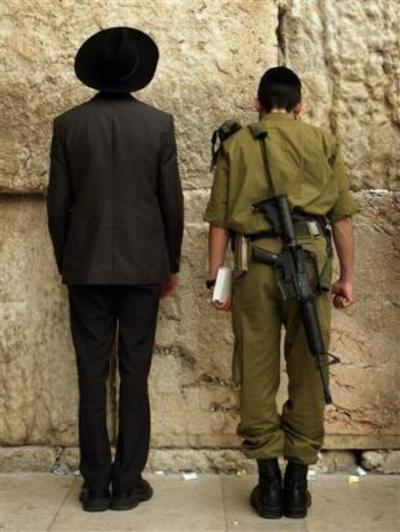I am loosely translating an article I read in a newspaper. It is quite long so I will do it in installments:
Our story beings in the year 1811. Rabbi Avraham Shlomo Zalman, a young rabbinic student from the Lithuanian town of Kiddan decides to answer the call of the students of the Gr”a. This group of students were organizing a large aliyah to Eretz Yisrael on the command of their Rabbi (who was no longer living). The purpose of the aliyah was clear: the closening of the redemption through earthly effort – the awakening of the Jewish people from below, which will in turn bring an awakening above – Devine aide that will complete the redemption.
Rabbi Avraham Shlomo Zalman took his wife Chana and their three children and departed on to a long journey which would last a year. On the road, he learned the craft of gold-crafting so that he will be able to earn a living from it in the land of the fathers and not need to benefit from charity.
In Hoshana Rabba of the year 1812, the family arrived in Acco. From there, they moved to Tzefat and joined the local students of the Gra (the prushim). After an epidemic broke out in the Galil, Rabbi Avraham Shlomo Zalman Tzoref decided to ascend to Yerushalaim.
The Ashkenazi settlement in Yerushalim at the time was poor, and in fact barely sustained itself. After the failure of the aliya of Rabbi Yehuda HaChasid from Poland in the year 1700, every Ashkenazi Jew was required to return the debts that the group of Rabbi Yehuda compiled with interest. The interest had accumulated over the years to massive amounts. The students of the Gra persisted and succeeded in establishing an Ashkenazi Perushi settlement in Yerushalaim.
Rav Avraham Shlomo Zalman occupied himself with Torah study and his craft. He learned Arabic from his neighbors. His greatness in Torah, his charisma, and his talents turned him into one of the leaders of the community of perushim in the city. The members of the community, which had begun to grow, needed their own synagogue. Naturally, they set their eyes upon the courtyard of the churba of Rabbi Yehuda HaChasid. The Arab owners, however, did not let the perushim take hold of the property. Rabbi Avraham Shlomo Zalman dedicated body and soul to the redemption of the Churba. In the end his struggle bore fruit, and the Egyptian ruler, Muhammad Ali – and later the Turkish sultan – permitted the returning of the courtyard to Jewish hands. The personal animosity of the Arabs towards Rabbi Avraham Shlomo Zalman grew as a result of his success and twice they made attempts at his life. The second time, on the 19th of Elul, 1851, they succeeded. Rabbi Avraham Shlomo Zalman Tzoref Hy”d became the first victim of Arab terror in the new Jewish settlement.
The son of Rabbi Avraham Shlomo Zalman, Rabbi Mordechai who took the surname Solomon (based on his father), continued in his father’s path and contributed much to the building of the synagogue ‘HaChurba,’ which was dedicated a year after his father’s murder, in Elul 1852. Rabbi Mordechai also became the first Hebrew farmer when he founded a farm in Elmansura (today known as Akron). He also authored a memorandum to Moses Montifiore containing a plan for the agricultural development of the land.
In this memorandum he wrote: “I shall trust in Hashem, Who shall grant me the bravery and strength to bring this task to success and wellbeing, since I am also from among those who learn Torah, nonetheless my soul hopes that God shall guide me to eat the fruit of my labor … I shall choose to sleep on the threshing floor in a village, since I know that all my hard work is good in the eyes of God – to put the spirit of life in the dry bones – the land of our fathers.”
Even during the life of his father, Rabbi Mordechai migrated to Chutz LaAretz where he learned the craft of weaving. Later, he purchased a vineyard in the Arab town of Beit Chanina. In the epidemic that broke out in Yerushalaim in 1865, a third of the Jewish population died – among them was Rabbi Mordechai.
To be continued …
Sunday, March 12, 2006
The chareidim of old, Part I
Posted by chardal at 3/12/2006 12:09:00 AM
Subscribe to:
Post Comments (Atom)
